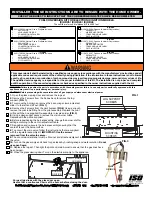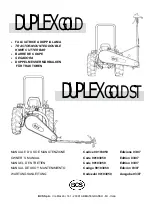
6RL SERIES OPERATION MANUAL
SECTION 9: CALIBRATION
Entire Contents Copyright
2018 by Adaptive Power Systems, Inc. (APS) • All Rights Reserved • No reproduction without written authorization from APS.
6RL Series Regenerative DC Load Operation Manual
Page 198 of 204
9
Calibration
9.1
Preface
6RL Series units support adjustment of the most important DC Input related values, which can
help in case these values are out of tolerance. The procedure is limited to compensate small
differences of up to 1% or 2% from the specifications. There are several reasons which could
make it necessary to readjust a unit: component aging, component deterioration, extreme
ambient conditions, high frequent use.
In order to determine if a value is out of tolerance, the parameter must be verified first with
measurement tools of sufficiently high accuracy and with at least half the error of the 6RL unit
specification. Only then can a comparison between values displayed on the 6RL unit and true DC
Input values be made.
For example, if you want to verify and possibly readjust the output current of model 6RL15-510-
80-4, which has 510A maximum current, stated with a max. error of 0.2%, you can only do that
by using a high current shunt with max. 0.1% error or less. Also, when measuring such high
currents, it is recommended to keep the calibration process short, in order to avoid the shunt
from over-heating. It is furthermore recommended to use a shunt with at least 25% current
margin.
When measuring the current with a shunt, the measurement error of the multi-meter on the
shunt adds to the error of the shunt and the sum of both must not exceed the max. error of the
unit under calibration.
9.2
Preparation
For a successful calibration and readjustment, a few tools and certain ambient conditions are
required:
A measurement device (multi-meter) for voltage, with a max. error of half the unit’s
voltage error. That measurement device can also be used to measure the shunt voltage
when readjusting the current.
If the current is also going to be calibrated: a suitable DC current shunt, ideally specified
for at least 1.25 times the max. input current of the unit and with a max. error that is
half or less than the max. current error of the 6RL model to calibrate.
Normal ambient temperature of approx. 20-25°C.
An adjustable voltage & current source capable of providing at least 102% of the max.
voltage and current of the 6RL load, or separate voltage source and current source units.
Before you can start calibrating, a few steps must be taken:
Allow the unit to warm up by running for at least 10 minutes under 50% power using the
Voltage/Current source.
In case the remote sensing input is going to be calibrated, prepare a cable for the
remote sensing connector to DC input, but leave it unconnected.
Abort any form of remote control, deactivate master-slave mode, set unit to U/I mode.
Install the shunt between source and 6RL load and make sure the shunt is cooled
somehow. For example, you might want to place it in the warm air stream coming out of
the rear of the 6RL load. This also helps the shunt to warm up to operating temperature.
Summary of Contents for 6RL Series
Page 203: ......







































